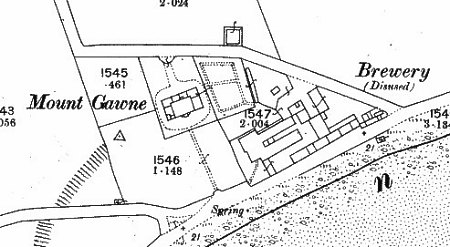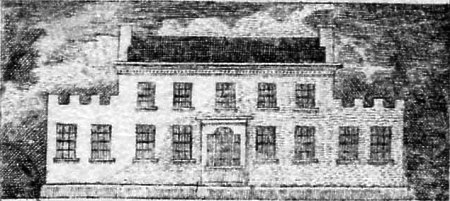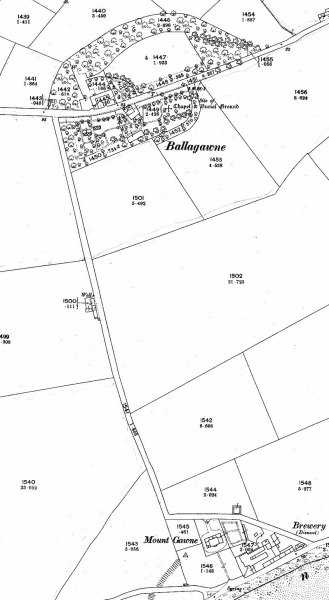Mount Gawne Brewery + Bank
This was built by Edward Gawne senr of Ballagawne in c.1790 - the Gawnes had been established for some considerable time
at Ballagawn in Rushen - see the family tree I added to the somewhat
circumspect account by A W Moore. It would appear that Gawne financed construction of the Brewery by a rolling £200
loan from John Qualtrough(Mill) starting in 1779 and not paid off until 1816. There was also a mortgage of £1000 granted
by John Taubman(Nunnery) on Ballachurry taken out in September 1790 [Enrolled deeds Oct 1790]and not discharged until 1820.
Thos Gawne on inheriting the property in 1791 and saddled with these incumbrances with the benefit going to his younger
brother Edward would probably not have improved relationship.
|
|
The plan extracted from sheet XVI-16 of 1868 1:2500 plan - Mount Gawne and the Brewery are shown in more detail below:

Edward Gawne give the recently constructed brewery, together with Malt Kilns in Port St Mary to his younger son Edward
as seen from SSS May 1794 138
dated 25 Oct 1790;Edward Gawne (gentleman, Ballagawne) + wife Jane als Taubman give to son Edward Gawne junr (maltster
+ brewer) that dwelling house wherein John Crebbin(Port St Mary) now lives [?SSS May 1782 109] together with my
malt house, malt kiln + yard together with that parcel of land lately purchased [SSS Oct 1782 98] from Wm Clucas
all situate near or in Port St Mary rent 3s 2d also those parcels of Ballagawne commonly called Kinnishes land (comp
5.5ac) + houses thereon erected, also those houses,croft etc part of Ballagawne lately held by John Shimmin(computed
1ac) together with all the new buildings lately erected for a brewery thereon + all pans, coolers, casks etc + the
well sunk near Shimin's croft for sd brewery and as much of the field wherein well is sunk as my be needed for access
etc - Edward junr to pay the prime costs of the pans etc + costs of putting up same when he reaches 21yrs (otherwise
to be levied as a mortgage - a penalty sum of £500 is mentioned) Witt Thomas Qualtrough, John Lace;

Edwd Gawn senr was dead by 1794 when deed passed thru court, and made his
will the same day - he died in 1791. The elder son Thomas inherited the estate. Edward started to build a new
house Mount Gawne close to the Brewery as shown in SSS Oct 1798 46 :
dated 22 May 1798; Thomas Gawne(Proprietor of Ballagawne, Rushen) + wife Alice Letitice sell for £21(British)
to Edward Gawne(Rushen) that parcel of Ballagawne whereon sd Edward Gawne has in part erected and is now erecting
a dwelling house bounded on south by sd Edward Gawne, on west by road leading from sea shore to Ballagawne and on
north + east by the new road now marked out between the parties containing abt 1 ac of ground; Witt J Shuttleworth,
Esther Gawne.
|
The Brewery was run at first by Edward Gawne - there are a few notes from him to M H Quayle (of George Quayle & Co)
acking for bills of exchange (needed in days before commercial banks became widely established) presumably so he could buy
material etc from English suppliers. In one such note [MS 04114] he writes of sending some Ale + Beer of real pan stuff
which is hard to be got in our day" and recommends Quayle to buy two or three barrels but adds "do not
think I want you to take it of my hands."
There must have been some development as Thomas sold his brother another small plot of ground as by SSS May 1816 62:
dated 7 Apr 1815;Thomas Gawne sells for £50(British) to Edward Gawne esq that small plot of land adj sd Edwd Gawne's
brewery concerns and stack yard on west, high road on NE + east and the shore road on south being of triangular form together
with houses now occupied by Wm Taubman + others erected on same; Witt Lucinda Robinson, Jas Shepherd.
In all of the deeds between Thomas and Edward they addressed each each formally with no note of their family connection
- Thomas Gawne was a close friend of Mark Quayle with a few personal letters to Quayle surviving in the Bridge House papers;
Quayle + Gawne would appear to share a strong interest in horse racing and horseflesh - Thomas was critical of his elder
sister's early marriage (she was soon widowed though no burial/will noted for her husband) and did not it seem have much
time for his brother Edward.
Edward Gawne married Catharine Moore(Kk German), daughter of Robert Moore + Cath Gelling, on 9 July 1801 at Kk Braddan
by Special Licence - the witnesses being Thos Gawne(his brother) and John Moore(her brother). He was appointed a MHK in
1803, which position he held until 1825.
Crumplin + Rawcliffe note that Edward Gawne along with other 'gentlemany' owners or brewers who indulged in the 'pastime'
of brewing was looking to exit the trade by 1826. In an advertisement in Manx Sun 16 Jan 1826 offering Mount Gawne
Brewery for sale by private contract stating that he is retiring from business and describes the brewery with Malt House
and every kind of building and utensil requisite for brewing 70 Barrels - along with a contiguous dwelling house in excellent
repair and capabable of accomodating a large family.
"It stands on a very healthy and elevated spot near the sea, commanding fine sea views, and within a mile of a convenient
sea port. The surrounding country producing an abundance of grain of the best quality. The water which supplies the brewhouse
is of the best kind , and was never known to fail the dyest summer. The Ale made from it produces the finest Yeast
in the Island, and from its superior quality alone commands a sufficient sale to cover the interest of the purchase money
- that is, the profit on the same of this article alone is equal to the interest on the money required. The elevation
too of the water commands the whole Brewery without the expence of manual labour. It is now, as it has been for many years,
fully at work, and possess the most extensive and suyccessful range of business in the Island."
He continues:
"Any Part, or even the whole of the purchase money, may remain secured on the premises. Any gentleman intending
to purchase it, may attend the Brewery for some time previous."
However there would appear to have been no takers for he finally 'sold' it in 1831 though I suspect died before the money
was called in as the deed only passed through the court after his death and one partner in sale would appear to be his son
Edward [Moore] Gawne junr[SSS Oct 1837 61]:
dated 22 Dec 1831;Edward Gawne(Kentraugh) sells for £5250(British) secured to be paid by Mrs Margaret Connal(widow)
and Edward Gawne junr all those concerns of houses, brewery lands + premises called Mount Gawne and Mount Gawne Brewery
as now in their possession consisting of a dwelling house, coach house, offices and Pidgeon house bounded by the highway
on the north east + south, by the inclose known as the 'sheep field' or Kinnishs Croft on west(wch field not included
)along with all my right + title to the reservoir or dam for collecting the water for use of the brewery situate on the
north side of the road in a field(property of Thomas Gawn) + also the said Brewery with the utensils, pans, coppers, coolers,
mash tubs, working tubs, troughs, spouts, casks of many descriptions marked "EG" together with Malt house, ware
house, dying kiln, cisterns, horse mill + machinery + cow house, cooperage, pigstys, cart house in the yard surrounding
sd brewery + coal yard, stack yard and workshop or barn adj the west side or back of sd Brewery together with labourers'
dwelling houses adj or east of sd brewery; Witt James MCrone, Michael Connal.
I strongly suspect that Gawne had lost interest in the brewing business long before this as he was already lending money
out at interest by the late 1790s and which became a significant aspect of his affairs from 1805 onwards.
In an outline of the history of Mt Gawne Brewery is given by Crumplin + Rawcliffe in Chap 1 of their book they note that
Mount Gawne had become one of the largest Island breweries by the 1840's with two coppers including one that could brew
50 barrels, its own malt kiln and houses for 7 labourers - this they implyed was mainly due to the go-ahead nature of the
brewer Michael Connal to whom it they say it was sold in 1843 - this I suspect was actually the calling in of the Connal's
share of the partnership which is noted as Gawne & Connal from 1837. Margaret and Michael Connal passed 3 identical
deeds of B + S to Jane, Margaret + Mary Ann Kerr (all spinsters, Edinburgh) for a total of £2000 - a half of sd undivided
brewery was passed as security to all three - there are also reference to a presumed Scottish deed also involving Wm Connal(merchant,
Glasgow) - deeds SSM Oct 1843 70,73 + 74 - none indicate that the money was repaid.
The Connal family are mostly together in the 1851 census living at Ballagawne with Margaret, widow aged 61, head of household
- she is probably widow of John Conal esq who is buried age 46 in 1831 at Rushen (Margaret is also buried there age 80 in
1869), also present is son Michael, the brewer, aged 40 (he later would appear to marry Lydia Barton Dutton one of the Duttons
associated with Villa Marina), two widowed daughters Marion Glas Gawne (widow of Edwd Gawne son of Thomas Gawn) and Margaret
Hinds(widow of Wm Hinds who were at Ballakissack Arbory in 1841) and unmarried daughter Euphemia who it seems was running
the actual brewing buiness.
However due to intense competition and the continued need for capital investment, it, along with other breweries, collapsed
in the 1850s - Euphemia Connal petitioned for bankruptcy in April 1854 [MM MS 05384A] noting that she had resided on Island
for 26 years (ie from 1828) and had been induced to enter into and carry on the trade and business of Brewing at Mount Gawne
Brewery under name of Connal & Co - she states that in consequence of certain losses and misfortunes .. which she could
not forsee .. is now an insolvent debtor. She petitions under the recently enacted 1852 Insolvent Debtors Act to avoid possible
imprisonment - the printed petition lists all her assets and debts leaving her with a pig, necessary wearing apparel and
a share in the IoMSPCo ! She stated that her brother Michael Connal gave her liberty to use Mount Gawne Brewery but otherwise
has no right in same.
Crumplin notes that the brewery was sold at a Coronor's auction in 1856 to satisfy a mortgage held by the Gawne family
- Edwd Moore Gawne sold it to Thomas Underwood in 1860 but it was gutted by fire in 1862 - the O/S plan of 1868 shows it
as disused.
Banking or Money Lending
There was a severe lack of small change on the Island in the early years of the 19th century - Gawne was apparently the
first to circumvent this by issuing card money in 1805 for small sums - in his case 2s 6d and 5/- but was soon followed
by many other tradesmen - Charles Clay describes the situation in chapter 6 of
his book. Some of this card money, the issue of which was curtailed by the 1811 Bankers Act are illustrated in West
+ Kelly's book though how West could determine the Edward Gawne of Mt Gawne was a banker originally from Bootle defies comprehension
- Edward Gawne's money lending on the security of land has left a huge paper trail of well over 600 deeds split between
Sales, Mortgages and Castletown deeds(so called as they went thro the courts at that time held in Castletown) - however
this business significantly predates his card money and would appear to have started in the late 1790s when he was barely
25. Note that though the various deeds for the money loaned were entered as Bond + Security they were actually legally mortgages
which under Manx law of that period allowed the mortgagor to take possession of any property after 21 years - a Manx law
which as Bluet in Advocates Notebook states:
NOTE. By the Act of Tynwald promulgated 6th July, 1835, the law as to "lapsed mortgages" is happily
altered, and now, upon the expiration of twenty-one years from the date of the mortgage, the mortgagee may levy his money
by execution, and thereunder sell the property given in security (or other property of the actual mortgagor), and pay himself
from the proceeds, the mortgagor being entitled to the balance, if any; but at no time can he now (as heretofore) by virtue
of a lapsed mortgage obtain or retain possession of the estate without regard to its relative value, to the prejudice of
the mortgagor's right to redeem.-See Jeffcotf's Statutes, xxii.
By the end of 1805, Edward Gawne had at least £2,000 outstanding on these loans - it is not at all clear as to where
the money came from - there is also in the same time period another B + S for £1000 joint with John Taubman.
Edwd Gawne was also one of the partners in the short lived Isle of Man Fire
Insurance Co of 1811 - he was also an investor partner in the George Hotel of Castletown. He was also apparently President
for life of the Rushen Friendly Society (his son Edwd Moore Gawne inherited this
position on his father's death) which was founded in 1811.
References
Tim Crumplin & Roger Rawcliffe A Time of Manx Cheer,Douglas: Manx Experience 2002 ISBN 1-873120-54-)
T.A. Bawden et al Industrial Archaeology of The Isle of Man David & Charles 1972 ISBN 0-7153-5440-X
Pam West and Alan Kelly Isle of Man Paper Money Sutton 2014 ISBN 978-0-9543457-4-7
Charles Clay Currency of the Isle of Man Manx Society vol XVII Douglas 1869


